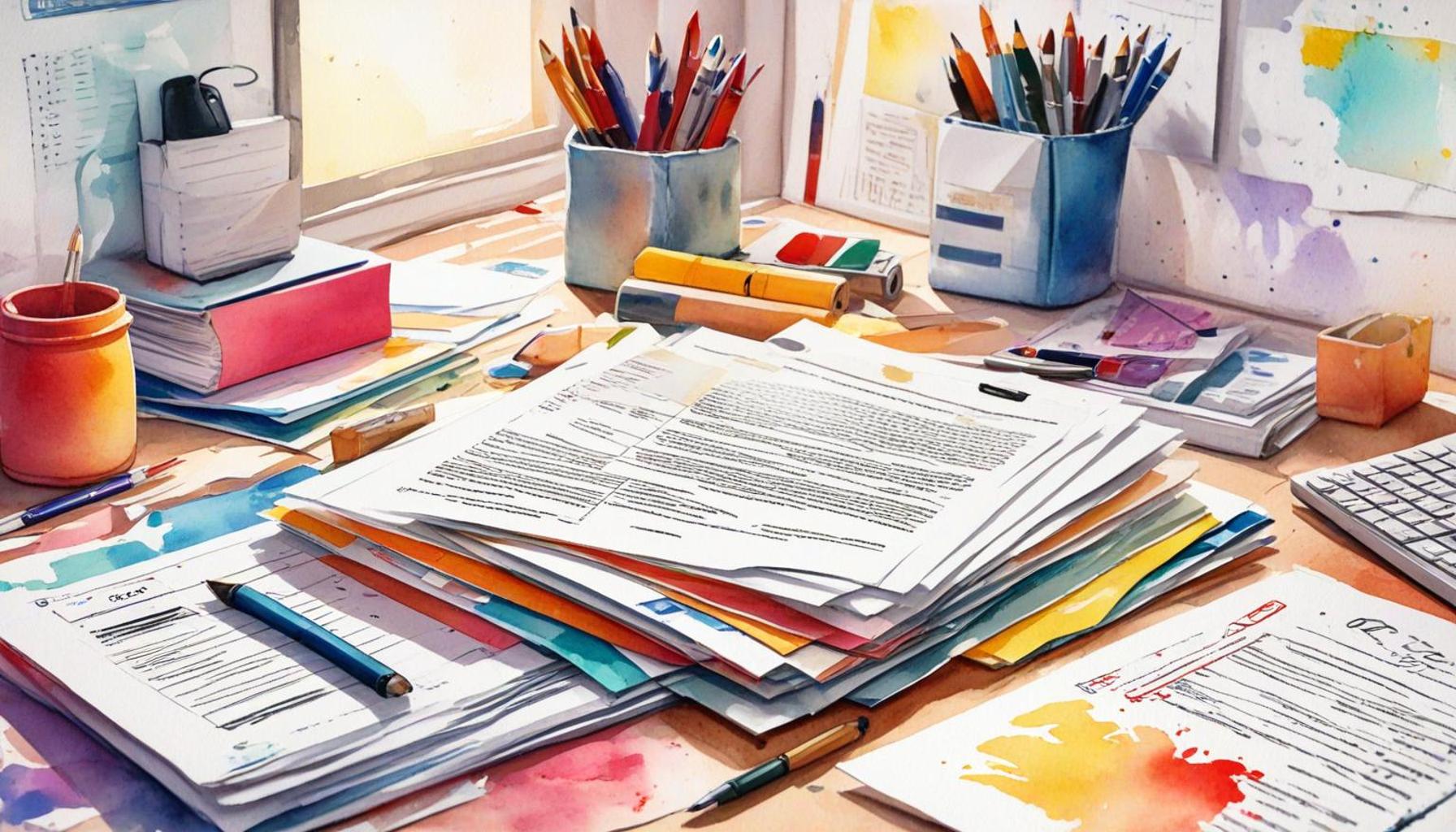Decluttering Digital: Tips to Clean Your Virtual Space and Increase Productivity

The Importance of Digital Decluttering
Our modern lives are intertwined with technology, and this relationship can quickly become overwhelming. As digital consumers, we face the daunting challenge of maintaining order amidst the chaos of files, notifications, and messages. The average office worker receives over 120 emails a day, leading to an information overload that can severely impact focus and productivity. In fact, studies show that clutter can distract us and reduce our cognitive performance by as much as 30%. Thus, it becomes vital to assess our digital spaces to identify whether it’s time for a purge.
Signs You Need to Declutter
Recognizing the signs that you need to declutter is the first step in reclaiming your digital life. If you find that your desktop is overcrowded, consider the impact of this visual clutter on your workflow. A messy desktop not only impedes your ability to find important documents but can also contribute to anxiety. Take, for example, a student who has numerous unorganized files littering their desktop; this can lead to missed deadlines and increased stress levels.
Next, if your email inbox resembles a never-ending scroll, it may be time for a comprehensive cleanup. With platforms like Gmail now offering more than 15GB of free storage, it can be tempting to let emails accumulate without regard. This not only complicates searching for essential communications but also increases the chances of overlooking important emails from colleagues or supervisors.
Moreover, if your social media accounts are overwhelmed with notifications, the distraction can take away from meaningful interactions. Studies indicate that constant notifications can fragment your attention, making it more challenging to concentrate on tasks that require deep thought and creativity.
The Benefits of Digital Decluttering
Taking the time to declutter your digital life goes beyond aesthetics; it fosters a healthier mindset. With an increased efficiency from streamlined workflows, you save time that would otherwise be wasted searching for files or sifting through unnecessary notifications. For instance, organizing online documents through cloud storage services like Google Drive can transform how quickly you access and share information.

Moreover, enhanced mental clarity will arise from a reduction of distractions. A tidy digital workspace can significantly boost your ability to focus, undoubtedly benefiting everything from work projects to personal pursuits. Engaging with fewer distractions allows individuals to channel their energy into creative endeavors that may have been neglected amidst the clutter.
Ultimately, achieving greater peace of mind is perhaps one of the most rewarding benefits of decluttering. When you know where to find the documents you need and can limit the influx of unnecessary digital noise, the result is often a calmer and more intentional approach to both work and leisure activities.
As we delve deeper into effective strategies and practical tips for digital decluttering, prepare to learn more about techniques that can fundamentally alter your online experiences and transform the way you work and socialize in a digital age.
DISCOVER MORE: Click here to streamline your space
Effective Strategies for Digital Decluttering
Now that we’ve established the significance of digital decluttering, it’s essential to explore practical tactics that you can implement to create a streamlined virtual space. From refreshing your email inbox to organizing your digital files, these strategies can empower you to enhance productivity and cultivate a more focused, efficient work environment.
Organize Your Files and Folders
One of the most impactful initial steps in decluttering your digital space involves organizing your files and folders. Much like a physical filing cabinet, your digital files benefit from a systematic approach. Here’s how you can implement this:
- Create a Hierarchical Structure: Begin by categorizing your documents into broad folders (e.g., Work, Personal, Projects). Within those folders, create subfolders that further break down your files (e.g., Client A, Client B under Work).
- Use Descriptive File Names: Opt for clear and descriptive naming conventions that will help you recall the contents of a file at a glance. Avoid generic names like “Document1” and instead use specific titles that indicate the file’s purpose.
- Establish Regular Review cycles: Set aside time every month or quarter to revisit your folders and archive or delete files that are no longer needed. This will keep your digital space from becoming cluttered again.
By implementing a clear organization system, you are setting the groundwork for a more efficient workflow. It minimizes time spent searching for documents, allowing you to devote more energy to completing tasks effectively.
Declutter Your Email Inbox
Your email inbox can easily become a digital black hole filled with unnecessary messages that drain your focus. To tackle this, consider the following strategies:
- Utilize Folders and Labels: Create custom folders and labels to categorize your emails by priority, project, or sender. This can help you easily locate important messages without scrolling endlessly.
- Unsubscribe from Unwanted Newsletters: Take the time to unsubscribe from newsletters and promotional emails that clutter your inbox. Tools like Unroll.me can simplify this process.
- Implement the Two-Minute Rule: If an email can be answered or dealt with in under two minutes, tackle it immediately rather than letting it sit.
These steps will not only render your inbox more manageable but also foster an environment where important tasks can be prioritized, reducing the chances of important communications slipping through the cracks.
Manage Notifications Wisely
In our always-connected world, managing notifications is crucial for retaining focus. The barrage of alerts can easily derail your train of thought and diminish productivity. Here’s how to regain control:
- Adjust Notification Settings: Assess which apps send you notifications and determine what is truly necessary. Turn off non-essential notifications to create a more peaceful digital environment.
- Consolidate Communication Tools: Using multiple platforms can be overwhelming. Streamline your communication channels by picking one or two preferred apps and encouraging colleagues to use those consistently.
- Schedule Time for Notifications: Instead of checking notifications as they arrive, designate specific times during your workday to review them. This will prevent constant disruptions.
By thoughtfully managing notifications, you will pave the way for more focused work sessions, allowing your brain to dedicate its resources to high-priority tasks without distraction.
Strategies for Effective Digital Decluttering
In the digital realm, maintaining an organized virtual space is essential for enhancing productivity and reducing stress. Below are some proven strategies that can help you achieve a tidier digital environment:
| Category | Description |
|---|---|
| Regular File Organization | Establish a systematic approach to categorizing files into folders, which simplifies retrieval. |
| Streamlining Applications | Evaluate and uninstall unused applications to free up storage and reduce distractions. |
| Regular Backups | Implementing regular backups ensures that your essential data is safe while allowing for decluttering. |
| Email Management | Use filters and folders to manage your email effectively, limiting inbox clutter and improving focus. |
By employing these strategies, you can significantly enhance your digital workspace, paving the way for increased efficiency and a more enjoyable online experience. Adopting a routine for digital decluttering ensures that your virtual environment remains a source of productivity rather than chaos.
Why Digital Decluttering Matters
Beyond mere aesthetics, digital decluttering plays an essential role in mental clarity and efficiency. An organized virtual space can enhance your focus and creativity, freeing up mental bandwidth for more important tasks. The correlation between a tidy digital environment and improved productivity is profound, as it minimizes distractions and helps maintain a clear workflow. Therefore, resolving to declutter your digital presence is a decision that echoes far beyond the screen; it promotes a healthier, more productive mindset.
DISCOVER MORE: Click here to transform your wardrobe</
Streamlining Your Digital Tools
As we continue to navigate the world of digital decluttering, it’s crucial to examine not just your files and notifications but also the tools you use daily. Many professionals utilize a variety of applications to manage tasks, from productivity software to project management platforms. However, having too many tools can create confusion and hinder efficiency. Here are some effective strategies to streamline your digital tools:
Assess Your Toolset
Take a moment to evaluate the tools you currently use in your day-to-day operations. Ask yourself:
- Do I use this app regularly? If you find yourself rarely using a specific tool, it may be time to consider uninstalling it.
- Does this tool integrate with others I use? Streamlined workflows often rely on the seamless integration of tools, so choosing applications that work well together is key.
- Does this tool meet my needs efficiently? If a tool feels cumbersome or lacks features that enhance productivity, consider looking for alternatives that offer a more user-friendly experience.
By methodically assessing your digital toolset, you can eliminate unnecessary clutter while ensuring you have the resources you need to excel in your work.
Use Cloud Storage Solutions
When it comes to file storage, embracing cloud storage solutions can significantly ease digital clutter. Services like Google Drive, Dropbox, and OneDrive allow for better organization and easier access to files. Consider these advantages:
- Accessibility from Anywhere: With cloud storage, you can access your files from any device with an internet connection, eliminating the need for physical storage devices.
- Collaborative Features: Many cloud storage platforms offer features for collaboration, enabling you to work efficiently with colleagues without the hassle of conflicting versions of documents.
- Avoid Data Loss: Cloud storage can protect against data loss resulting from hardware failures, as your files are stored safely online.
Transitioning to a cloud-based system can significantly enhance your ability to maintain an organized digital workspace while providing the flexibility required in today’s agile work environment.
Regularly Update Your Digital Devices
It may seem basic, but regularly updating your digital devices can have a significant impact on performance. Outdated software can slow down your systems, making everyday tasks feel labor-intensive. Consider the following:
- Set Up Automatic Updates: Configure your operating system and applications to update automatically. This reduces the frequency of interruptions and ensures you are always running the most efficient version of your software.
- Remove Unused Applications: Just as you would with files, regularly audit the applications on your devices. Uninstall those that no longer serve a purpose, freeing up storage space and potentially improving performance.
- Consider Upgrading Hardware: If performance issues persist even with updates, it might be time to invest in new hardware that better supports your needs and improves overall productivity.
By staying proactive about updates and maintenance, you ensure that your digital devices serve as an asset rather than a hindrance in your quest for productivity.
Set Boundaries for Digital Engagement
Establishing boundaries around your digital engagement is vital in today’s hyper-connected world. Too often, we can find ourselves overwhelmed by an influx of information and demands for our attention. Here are some suggestions to help establish healthy boundaries:
- Designate “No Screen” Times: Allocate specific times each day to disconnect from screens and engage in other tasks like reading, exercise, or spending time with family.
- Create Focused Work Blocks: Carve out blocks of time dedicated solely to tasks without interruptions from emails or notifications. Consider using techniques like the Pomodoro Technique to enhance focus during these periods.
- Use “Do Not Disturb” Modes: Utilize features on your devices that silence notifications during work sessions to help you maintain focus and minimize distractions.
By implementing these boundaries, you can foster a healthier relationship with technology and enhance your ability to focus on meaningful tasks, ultimately increasing your productivity.
DISCOVER MORE: Click here for insightful strategies
Conclusion
In a world where digital clutter can easily spiral out of control, implementing effective strategies to declutter your virtual space is essential for enhancing productivity. By assessing your toolset, adopting cloud storage solutions, regularly updating your devices, and establishing boundaries for digital engagement, you can create a more streamlined workflow. Each of these steps not only minimizes distractions but also leads to a more organized approach to work and personal tasks.
As you embark on your digital decluttering journey, consider the profound impact it can have on your mental clarity and overall productivity. Studies suggest that a clean digital workspace can reduce stress and foster creativity, allowing you to focus on what truly matters. Make it a habit to routinely evaluate your applications and files, ensuring that they are functional and beneficial to your goals. Remember, less is often more, and the tools you choose should empower you rather than overwhelm you.
When you embrace these decluttering techniques, you are not merely tidying up; you are cultivating a productive environment that promotes efficiency and personal growth. So take the time today to transform your digital landscape and unlock your full potential. The journey to a clutter-free virtual space is not just about organization; it’s a pathway to enhanced focus, reduced anxiety, and increased output.


